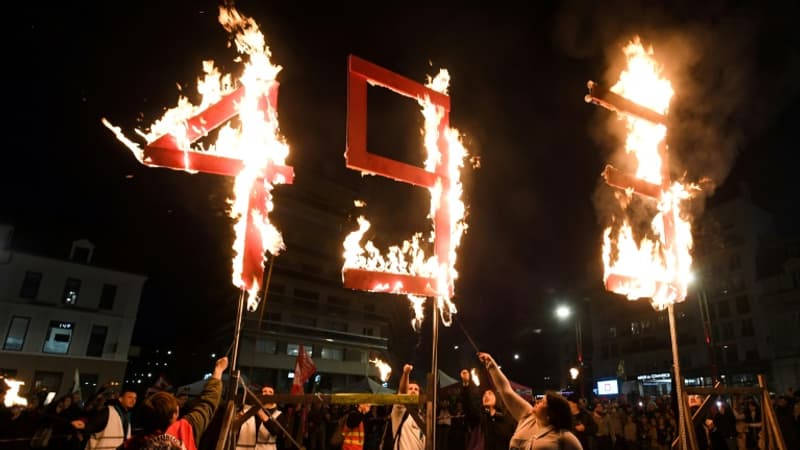“It’s not up to us to release it, it’s up to the government to withdraw its text,” Claire told BFMTV.com. She has been demonstrating since the first demonstrations against the pension reform, but she has redoubled her ardor since last Thursday and the use of Elisabeth Borne’s 49.3 to approve the text without the vote of the deputies.
Since Thursday, every night, he has participated in rallies in Paris to show his discontent. After eight days of rather classic demonstrations against the pension reform, organized by the unions, the protest movement for the pension reform seems to have changed. Or rather, a new form of mobilization has been added to the one claimed by the inter-union.
“Very mobile small groups”
The Paris police prefect, Laurent Nuñez, described it this Tuesday on BFMTV. It is made up of “small, highly mobile groups”, “very fragmented” and “that do not exceed 200, 300 people”. According to Laurent Núñez, these groups “form very quickly” and “commit a lot of abuses”, citing the head of Parisian internal security barricades of burnt garbage cans.
Interior Minister Gérald Darmanin gave on Tuesday the figure of 1,200 undeclared demonstrations throughout France since last Thursday. They took place in Paris, but also in Rennes, Lille, Nantes…
A complicated police action
This form of mobilization makes it difficult for the police to intervene, according to David Leveau, Brittany regional secretary of the SGP Police FO Unit, who described the BFMTV protesters on Monday as “ultra-mobile”.
“We found ourselves playing cat and mouse in the small alleys of Paris. There, we switch more to urban violence and it’s a bit more complicated for us because sometimes we find ourselves understaffed,” Reda Belhaj, a spokeswoman for the Île, told BFMTV on Tuesday. -de-France branch of the same union.
If he said “understand the anger” of the people who demonstrate against the pension reform, he considered that the “problem” was “violence”.
Law enforcement disperses
On Monday, a Parisian protester told AFP he had adopted the “be water” method, popularized by the 2019 Hong Kong protests. Reference to Bruce Leethe concept of “being water” is to move fluently so as not to be caught by the police.
But for Claire, this form of mobilization does not respond to a planned strategy: “there are attempts to make large processions, like the first night between Saint-Lazare and Opéra,” she points out. The protester explains that “the dispersal comes from the police”: “we are asking to demonstrate, but it is the police who are trying to dismantle the groups. And despite the repression, the people stay, I find it quite moving.”
an independent movement
The police intervene in particular because these demonstrations are not declared in advance, Gérald Darmanin defended before the BFMTV microphone on Tuesday. But to declare them, “it would take an association, a party, while the protesters come spontaneously”, observes Claire.
The researcher at the Sciences Po Political Research Center (Cevipof) Guy Groux also points out with BFMTV.com an “autonomy of this protest movement”:
But neither is it against the unions, according to the sociologist specializing in militancy, who anticipates that the marches announced for Thursday by the inter-union will bring together a lot of people. unions like CGT EITHER Solidarity They have also shown their support for certain actions in recent days.
For his part, the political scientist specialized in union organizations Dominique Andolfatto sees in this new mobilization a “convergence between a radical wing of certain unions and another form of activism, with young people, more or less elusive and more radical movements.”
Claims that have evolved
In the demonstrations, anti-Macron slogans are increasingly mixed with slogans against the pension reform itself. Guy Groux underlines “a shift from the social to the political”, with “an anti-Macron movement, anti-personalization of power”.
The Government seems determined to approve its pension reform at all costs, which has yet to obtain the approval of the Constitutional Council. Again on Wednesday, Emmanuel Macron affirmed his wish that it enter into force “at the end of the year”.
What possible sequel?
The sociologist Guy Groux puts forward three hypotheses for the rest of the protest: “protesters who are getting tired (but it is unlikely), more and more people in these demonstrations with public places occupied, or that the government temporarily suspends its reform.
The political scientist at the University of Burgundy Dominique Andolfatto gives another reading: “if the current social movement evolves towards forms of action that adopt the characteristics of riots, it will not last long because public opinion will condemn it and it will no longer go to trade”. union demonstrations.
Emmanuel Macron in any case sent a clear message to these protesters, saying on Wednesday that he could accept “neither the rebels nor the factions” and would not tolerate “any spillover”.
Source: BFM TV


